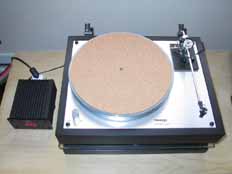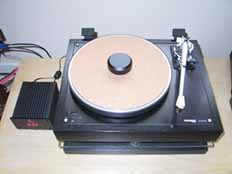The first TD160 was introduced in 1972 as a replacement for the TD150. The new turntable included various (mostly small) improvements over its forebear to items such as the bearing and motor and came with the TP16 tone arm.
The TD160 went through numerous small revisions on its way through MkII (1976), MkIV (1987) and MkV (1988). The MkV benefited from a 16v AC motor shared with other Thorens decks in production at the time. I’ve never heard of a reference to a Mk III, but such a machine may well have existed; answers please. There was also a version of the MkII with an opto-electronic shut off, the TD160 E (Endabschaltung).
There were ‘armless’ versions of the decks produced too. In most cases the addition of the letters ‘B’ or ‘BC’ (Base) to the model number identified this; e.g. TD160 B Mk2. The most popular after-market arm at the time seems to have been the SME 3009 series. The informal association of Thorens and SME was to continue through the life of the TD160 range and on to the Thorens ‘Ambience’ of 1991 which came as standard with an SME 309.
Audiophile pretensions?
Throughout the production of the Thorens TD160 there have been numerous tweaks and after-market modifications available. In 1983 Thorens finally bowed to pressure from the UK distributor and produced a factory-tweaked version of its TD160 MkII, this was known as the TD 160 Super. Although this deck used the standard motor, plinth, top plate and sub-chassis they were all slightly changed. The motor was a more closely toleranced version of the 110v 16-pole synchronous AC unit used previously. The plinth gained a thick, heavy fibreboard base plate and the top plate and sub-chassis were both treated with dense black bituminous felt material; all to reduce resonances in the structure. It is believed that the main bearings were different to the stock item; they neither look nor measure any differently when compared to a TD160 B. However, the TD160 Super in my collection is somewhat quieter than the TD160 B, which raises a suspicion that the bearing units may have been specially selected.
There are later versions of the tweaked ‘table, a TD160 Super MkII and TD160 S MkIV BC. And then there’s the potential giant killer...
So nearly so good; the last hurrah.
The 1989 Thorens TD160 S BC V. Or to take the description from the model number; a TD160 with audiophile tweaks, no arm and at MkV standard. So what do you get? A turntable that looks like a normal TD160 that’s for sure; but with the 16v AC motor of the later versions you get smoother and quieter drive that improves the sound considerably. The sub-chassis is a different shape, thicker and stronger than that previously supplied. But the real advantage is the main bearing which this deck shares with the ‘Ambience’. Unfortunately Thorens didn’t quite succeed in gilding this particular lily, the thin hardboard base-plate resonates in sympathy with any vibration that reaches the plinth, the main bearing is held into the sub-chassis with a circlip and the transformer supplied for the motor is small and severely limits the turntable’s overall performance. However these are not insurmountable problems if you can find one to start off with!
Setting up the TD160
The biggest weakness on the standard TD160 was always the Thorens arm. Not that it’s a bad arm, just that there are (and were) better ones. As mentioned above the SME 3009 series was popular with the early marks to the point that SME actually made an arm board to mount the 3009 onto the TD160. This is an aluminium die casting of very high quality that positions the arm correctly; but it needs some care to fit, as there is some material that needs to be removed from both the sub-chassis and the top plate. Thankfully the instructions are clear and a full set of fixings is supplied. This arm board is also believed to suit the Series III arm.
After the SME Series V arm was introduced in 1986 SME started producing a variation of the arm board with different machining and fixings for use with this arm. This is the item of choice should you be thinking of fitting an Series V, Series IV or 309 to a TD160. In this regard the SME IV might well be regarded as the de-rigueur item for the S BC V.
Other arms are also suitable. The Mayware Formula 4 falls into the oldie-but-goodie category. This is a UK built unipivot of the early 1980s. Combined with the TD160 Super and a modest cartridge this is an excellent combination with plenty of drive, energy, exceptional imaging and wonderful timing. Other unipivots to consider include the Naim ARO (which was designed for a certain Scottish-built Thorens TD160 clone), Hadcocks’ and the Audiocraft arms.
Gimballed arms might include those made by Helius or Syrinx if you don’t fancy an SME. Rega arms are worth considering, but only if you feel comfortable spending a lot of time fine tuning the set up and in most cases give an exaggerated flat yet somehow fatiguing sound. So they’re not highly recommended, though I’m sure their popularity and reputation means that plenty of people will disagree...
For those who’re interested in modern alternatives the Roksan Nima unipivot or SME M2-9 (use the SME armboard for the Series IV) as the spiritual successor to the 3009 would be worth a try and the Hadcock arms are still in production. Linn and Roksan arms are also suitable as they’re designed to work with similar turntables.
In all cases the deck performs best when on a level stand or wall bracket and (importantly) with the suspension properly set so that the platter and plinth are perfectly level when playing a record.
Tweaks and Upgrades
Decent clean power makes quite a difference to the Thorens, as it does to the vast majority of turntables. For the 16v AC versions Pro-ject come to the rescue. Their standard 16v transformer is larger than the one supplied by Thorens and is apparently available as a spare. For the more ambitious the Pro-ject Speedbox allows electronic speed switching of the 16v Thorens’. The resonant, mechanical speed change parts can then be removed.
The mains powered TD160 can also be fitted with an external PSU. A suitable unit is available from Moth Group in the form of the Pure Cycle. The Pro-ject Speedbox SE provides both 220v AC and 16v AC outputs and is highly recommended by the author for either motor version - it's large transformer and quartz controlled frequency generator lead to large audible gains. And then there’s the Origin Live DC motor conversion that also works well, though it does need some DIY skills to fit.
Other than the audiophile versions it’s worth damping the top plate and sub-chassis with bitumen panels or cork sheet stuck in with Copydex. The suspension units should have the foam removed from the springs (especially if it’s perished!) and Linn equivalents from the LP12 can be used to replace the springs and bushes themselves. The latter is not always an easy job as the threaded rods supporting the springs are not quite long enough.
If your Thorens TD160 has a hardboard base plate it can be removed entirely or replaced with one cut from thicker chipboard or MDF. Clearlight Audio also does an RDC base plate custom designed for the TD160.
The Thorens TD160 tune-up kit from Moth Group consists of a set of rubber rings that act as ‘peripheral wave traps’. These go around the bearing, motor and platter and are supplied together with a motor thrust bearing. With careful fitting these add greatly to the sound.
The inner and outer platters can be damped with cork sheet. Good care must be taken to keep the bearing clean if attempting this however. The effect is not subtle and can be further improved by using a cork platter mat. The best cork to use is probably the 2.4mm cork/neoprene sheet used by the model railway fraternity as ‘underlay’, between the board and track. A word of warning though; the extra thickness under the outer platter can foul on the motor pulley or safety post, so some careful consideration is needed before attempting.
Then there’s the question of whether any (all?) of these changes are true upgrades. I’ll chicken out and leave that to your own judgement; changes certainly, but only your ears can decide if they’re true upgrades! It’s interesting to consider that upgrade parts are newly developed for the TD160 occasionally so even for this elderly deck, some years after it finished production, the story is far from over.
There is no doubt that even the top-flight set up of the TD160 has all the charisma of a breezeblock; in looks it’s nothing to compare with anything made by Michell et al in those particular stakes. But it the context of suspended sub-chassis ‘tables of similar vintage the TD160 can hold its head high. Properly set up, correctly sited and with good ancillaries the qualities of the deck shine through; fast, deep bass, a surprisingly neutral mid-band and crisp, clear treble combine to give a performance that’s both insightful and musically involving. Admittedly in this set up it ceases to look particularly cheap but pound for sound it remains better value than it’s most obvious comparison. Most people will always score the competitors more highly. But we know better; don’t we?
Further Reading
Of course an article like this can’t tell the whole story. There’s plenty more information available on the internet and elsewhere, as well as fairly active user groups and enthusiasts of the marque. In that regard it’s a bit like owning a classic car!
There is some sensible advice out there, one piece of which is worth reiterating. Much like classic cars, it’s worthwhile hunting out a low mileage and completely original deck than risk buying a tweaked deck unless you know its pedigree and true value. The vast majority of parts are not available as spares (thankfully belts are) so buy with care.
Of course with such a popular turntable there are plenty of sources of information (just try thumping the search phrase ‘Thorens TD 160’ into Google) and I've put a couple of good links on the (hey guess where?) links page.
You can click on the pictures below to see more photos and information.


